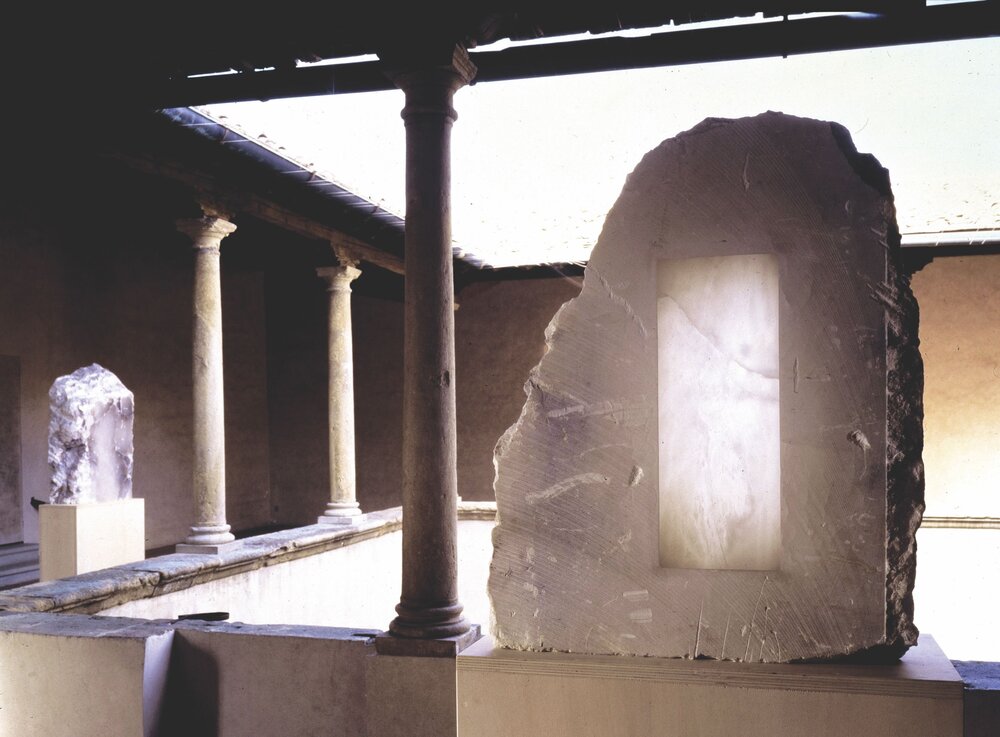The city of Volterra was home to a series of works by Anish Kapoor created for the second edition of Arte all’Arte, curated by Jan Hoet and Giacinto di Pietrantonio.
“But darkness has its counterbalance in light, just as the non-color black has its opposite in white, the sum of all colors. And it is toward this luminous totality that Kapoor’s research has moved in recent years, with white parallelepiped works that once again seem to dissolve form into light. This light is the essence of the work placed in front of the Church of San Bartolo in Volterra. Here stands a large block of white marble, where only the side facing the church façade is worked, while the others are left rough, revealing matter in transformation, in energetic potential.
The front of the work, on the other hand, appears smooth and solid from a distance, but as we approach it, we realize it has been polished, hollowed out to form a concavity that draws us inward. It is as if the stone breathes, creating an inner passage, a void that is no longer a black hole and no longer needs to be a colored cavity, because it is now a luminous surface that captures us from within, that traps both body and soul, giving us a real sense of what Michelangelo meant when he said: ‘Sculpture is made by removing, painting by adding.’
Indeed, the crucial point in Kapoor’s work lies precisely in that moment when the viewer’s perception shifts from the solid image of the block to that of the void, in the instant when the white, flat, painterly surface becomes sculpture—and vice versa. Thus, the painter Kapoor, who expresses himself through sculpture, in reflecting on Michelangelo, reveals to us the illusory essence of appearance and the deep light of being. And in this relationship, we can say that art returns to art—and for this reason, it is eternally contemporary.
Returning to art with the images of being—our unknown and unknowable being—to which humanity has always tried to give meaning through all its religious, philosophical, and scientific expressions, posing the eternal questions: Who are we? Where do we come from? Where are we going? The artist, by fusing knowledge and experience, reveals this being to us as the pneuma of matter, the breath of the world.
In this light, we might say that Kapoor’s “stones” are also a kind of alchemical attempt—a new path in search of the philosopher’s stone. Not one that transforms base metals into gold, but something far more precious: the form and spirit of being, of art, and of life. This is also visible in the four alabaster sculptures created in Volterra and housed in the city’s Pinacoteca, where each work is at once full and empty, heavy and light, luminous and golden.
Here, thanks to the translucent properties of the material, the artist strengthens the sense of transition from painting to sculpture and from painting to its aerial dissolution into pure light—completing the full cycle. For if form belongs to sculpture, light belongs to painting. This is the light of matter, a golden light like that of the philosopher’s stone, which captures the moment of transition as a unification of appearance and being—like sunset closing the day, or dawn opening a new one.
And here lies the answer to those who question the meaning of painting, sculpture, the artist, and art itself: for it becomes clear that the duality in Kapoor’s work is, in fact, a creative circularity—like the natural rhythm of the seasons, the movement of planets and the cosmos—acting between the individual and the collective, and thus becoming, like nature itself, an art that creates the world."
Jan Hoet, Arte all’Arte II, 1997

